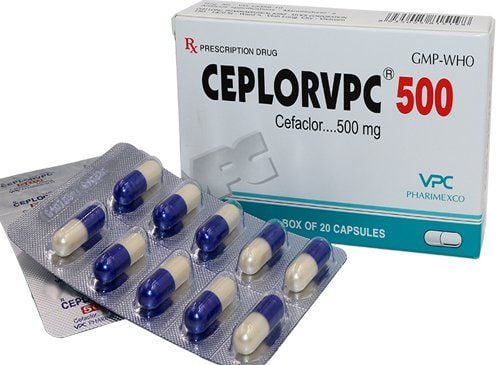This is an automatically translated article.
Cadicefaclor drug is made in the form of hard capsules, with the main ingredient being Cefaclor. The drug is used in the treatment of certain bacterial and infectious diseases.
1. What is Cadicefaclor?
What is Cadicefaclor? 1 Cadicefaclor tablet contains the active ingredient Cefaclor (as Cefaclor monohydrate) and other excipients. There are strength forms of the drug: Cadicefaclor 250 (including 250mg of Cefaclor) and Cadicefaclor 500 (including 500mg of Cefaclor).
The main active ingredient of Cadicefaclor is Cefaclor - a broad-spectrum antibiotic, a semi-synthetic antibiotic belonging to the 2nd generation cephalosporin group. The drug has a broad antibacterial spectrum, including gram-negative bacteria, gram-positive bacteria. Cefaclor kills bacteria by inhibiting bacterial cell wall synthesis. Since then, the bacteria cannot create a cell wall, which will be broken under the action of osmotic pressure. The outstanding advantage of Cefaclor is that it has a strong effect on gram-negative bacteria and this drug is also stable to bacterial beta - lactamase enzymes, thereby avoiding drug resistance.
Indications for the use of Cadicefaclor: Treatment in cases of bacterial infections sensitive to the drug:
Upper respiratory tract infections: Ear - nose - throat infections, especially tonsillitis, sinusitis, otitis media ; Lower respiratory tract infections: Bronchitis, exacerbation of chronic bronchitis; Skin and soft tissue infections; Uncomplicated urinary tract infections: urethritis, cystitis, pyelonephritis caused by gonococcal bacteria. Contraindications to the use of Cadicefaclor: People who are allergic to beta-lactam antibiotics.
2. Instructions on how to use Cadicefaclor
How to use: The patient should take the whole Cadicefaclor tablet, take it on an empty stomach.
Dosage: Depending on the specific case according to the doctor's prescription. The usual dosing time is 7-10 days. Refer to the following dosage:
Adults:
Usual dose: 250mg x 8 hours/time; Bronchitis, pharyngitis, tonsillitis, lower urinary tract infections, skin and soft tissue infections: Dosage 250 - 500mg/time x 2 times/day or 250mg/time x 3 times/day; Recurrent pharyngitis due to group A beta-hemolytic streptococci: Treatment should be given to even asymptomatic carrier members of the family. For acute pharyngitis, the first drug of choice is penicillin - V; More severe infections: 500mg/time x 3 times/day. The maximum dose limit for adults is 4g/day. Children:
Usual dose: 20 - 40mg/kg body weight in 24 hours, divided into 2-3 oral doses; Otitis media: 40mg/kg body weight in 24 hours, divided into 2-3 times, but the total daily dose should not exceed 1g; Children under 1 month of age: The safety and effectiveness of the drug has not been determined; Maximum dose: Not more than 1.5g/day; Infections caused by beta-hemolytic Streptococcus: Treat with cefaclor for at least 10 days. Other subjects:
Elderly people: Take the same dose of Cadicefaclor as adults; Patients with renal impairment: In case of severe renal impairment, the dose should be adjusted as follows: Creatinine clearance 10 - 50ml/min: Use 50% of the usual dose; Creatinine clearance less than 10ml/min: Use 25% of the usual dose; People on hemodialysis: During hemodialysis, the half-life of cefaclor in serum is reduced by about 25 - 30%. Therefore, patients on regular hemodialysis should receive an initial dose of 250 mg - 1 g before hemodialysis, maintaining a therapeutic dose of 250 - 500 mg every 6 - 8 hours in the interval between dialysis sessions. Cup. Overdose: When using Cadicefaclor drug overdose, patients have symptoms such as nausea, vomiting, diarrhea, epigastric pain. Severity of epigastric pain and diarrhea is dose related.
Treatment in case of overdose is:
No need to wash the stomach - intestines unless the patient has taken Cefaclor at a dose 5 times higher than the normal dose; Should protect the patient's respiratory tract, support ventilation and infusion; Give the patient activated charcoal to drink many times to reduce drug absorption; Gastric lavage can be combined with activated charcoal or activated charcoal alone.
3. Cadicefaclor side effects
When using Cadicefaclor, patients may experience some side effects such as:
Common:
Blood: Eosinophilia; Digestion: Diarrhea; Skin: Measles rash. Uncommon:
Whole body: Positive direct Coombs test result; Blood: Leukopenia, lymphocytosis, neutropenia; Skin: Skin itching, urticaria; Gastrointestinal: Nausea, vomiting; Urology - genitourinary: Vaginitis, genital itching, candidiasis. Rare:
Systemic: Fever, anaphylaxis, serum sickness-like symptoms, generalized pustular skin rash, Lyell syndrome (toxic epidermal necrolysis), Stevens - Johnson syndrome. Serum sickness-like reactions are more common in children than in adults with manifestations such as erythema multiforme, with or without fever, inflammation or arthralgia, possibly with lymphadenopathy, proteinuria; Blood: Hemolytic anemia, thrombocytopenia; Liver: Hepatitis, increased liver enzymes, cholestatic jaundice; Gastrointestinal: Pseudomembranous colitis; Renal: Slight increase in blood urea or serum creatinine, abnormal urinalysis, reversible interstitial nephritis; Central nervous system: Increased agitation, seizures (if high doses are used and the patient has impaired renal function), restlessness, headache, insomnia, confusion, dizziness, hallucinations , hypertonia, somnolence; Other organs: Joint pain. Patients should immediately inform their doctor about the side effects they experience when using Cadicefaclor for advice on the most appropriate treatment.
4. Notes when using Cadicefaclor
Some notes for patients to remember before and while taking Cadicefaclor:
Be careful when using Cadicefaclor in patients with a history of hypersensitivity to cephalosporins, especially to Cefaclor or penicillin; Long-term use of Cefaclor can cause pseudomembranous colitis, so it should be used with caution in patients with a history of the gastrointestinal tract, especially colitis; There are no adequate studies on the use of Cadicefaclor in pregnant women. Therefore, the drug should be used only when absolutely necessary, with the permission of the doctor; Cefaclor is excreted in breast milk, so caution should be exercised when used in lactating women; Drivers and operators of machinery should be aware of the risk of hallucinations, dizziness and somnolence when taking Cadicefaclor.
5. Cadicefaclor drug interactions
Some drug interactions of Cadicefaclor include:
Probenecid may increase the concentration of active substance Cefaclor in serum; Cadicefaclor may increase nephrotoxicity when used concomitantly with aminoglycosides or with the diuretic furosemide. When using Cadicefaclor, the patient should follow all instructions of the treating doctor to ensure the best infection treatment effect and significantly limit the possible risks.
Follow Vinmec International General Hospital website to get more health, nutrition and beauty information to protect the health of yourself and your loved ones in your family.
Please dial HOTLINE for more information or register for an appointment HERE. Download MyVinmec app to make appointments faster and to manage your bookings easily.













